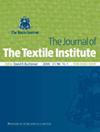黄麻织物增强聚合物基复合材料的二步法研究
IF 1.5
4区 工程技术
Q2 MATERIALS SCIENCE, TEXTILES
引用次数: 1
摘要
摘要本文主要研究了以未处理黄麻织物和挤压黄麻织物为原料制备黄麻增强聚合物复合材料(FPC)的工艺。采用不同组分共混比α(树脂/溶剂比)的聚合物分别对拉伸黄麻织物进行加工固化。采用两步法,在拉伸黄麻织物中采用不同配比的聚合物共混比例α1,在基体中采用不同配比的聚合物共混比例α2制备复合材料试样,对纤维/基体拉伸应力、断裂应变、韧性和杨氏模量均有积极影响。α1和α2的最佳值为0.6,可使复合材料具有较高的拉伸强度和杨氏模量。本文章由计算机程序翻译,如有差异,请以英文原文为准。
Investigation of 2-step technique for jute fabric reinforced polymer matrix composite
Abstract This paper focuses on the fabrication processes of jute reinforced polymer composites (FPC) made with the use of both untreated jute fabric and pultruded jute fabric. The pultruded jute fabric performs were processed and cured separately using polymer with different components blending ratio ‘α’ (resin/solvent ratio). 2-step technique where the composite specimens were prepared using a different combination of polymer blending ratio α1 for the pultruding jute fabric and used blending ratio α2 polymer for the matrix, which have contributed positively to fiber/matrix tensile stress, breaking strain, toughness and Young’s modulus. The best value of α1 and α2 to have composite with high tensile strength and Young’s modulus was 0.6 for both the pultruded matrix and final composite matrix.
求助全文
通过发布文献求助,成功后即可免费获取论文全文。
去求助
来源期刊

Journal of the Textile Institute
工程技术-材料科学:纺织
CiteScore
4.20
自引率
5.90%
发文量
149
审稿时长
1.0 months
期刊介绍:
The Journal of The Textile Institute welcomes papers concerning research and innovation, reflecting the professional interests of the Textile Institute in science, engineering, economics, management and design related to the textile industry and the use of fibres in consumer and engineering applications. Papers may encompass anything in the range of textile activities, from fibre production through textile processes and machines, to the design, marketing and use of products. Papers may also report fundamental theoretical or experimental investigations, including materials science topics in nanotechnology and smart materials, practical or commercial industrial studies and may relate to technical, economic, aesthetic, social or historical aspects of textiles and the textile industry.
All published research articles in The Journal of The Textile Institute have undergone rigorous peer review, based on initial editor screening and anonymized refereeing by two expert referees.
 求助内容:
求助内容: 应助结果提醒方式:
应助结果提醒方式:


